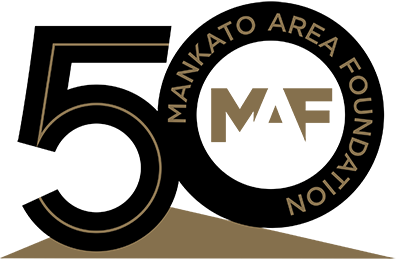Mankato Free Press (May 15, 2024) —The new Shared Spaces Emy Frentz builds not only on the success of the original Shared Spaces building a few blocks away, but adds the successful collaborative spirit brought forth through Twin Rivers Council for the Arts.
At the urging of nonprofits to be served, Interior space uses were flopped from when Twin Rivers occupied the building. Now, the former Christian Science Church reading room in the rear is divided into up to nine office cubicles for arts-based nonprofits. Rents will be as little as about $270 per month.
The front sanctuary, which had housed several artists’ studios, has been opened up and is available for larger meetings, presentations or performances. In doing so, original lights, woodwork and colorful charm were returned to the space, along with tons of natural light.
“This is just amazing. I mean, what a great place for a lot of convenings and just people gathering,” exclaimed Mankato Area Foundation Past Chair Kristin Weeks Duncanson as she entered the space a couple of days before construction was to cease.
“Nonprofits work best when they work together,” she added, echoing the mission that has worked so successfully to guide MAF’s first Shared Spaces: A Center for Nonprofit Collaboration” at 127 S. Second St.
The former law office now houses such community nonprofits as Life-Work Planning Center, Greater Mankato Diversity Council, YWCA Mankato and Greater Mankato Area United Way, not only reducing overhead costs but encouraging and facilitating essential collaboration between them. Retention of organizations has been about 95 percent.
Through the generosity of developer Tony Frentz, whom Zallek called a “significant partner,” MAF is now housed in the adjacent building at 212 E. Walnut St. Frentz again came forward to donate the Emy Frentz building, named for his late mother, to expand the mission to the arts, for which his mother is known.
“This space has been incredibly personal to him,” she said of the Frentz building, “so the only caveat he had … was just that we keep his mom’s name,’ said Executive Director Nancy Zallek.
With the original Shared Spaces, Zallek speaks of how the organization approached 11 people and came away with nine donors. That reaction showed them the concept was embraced by supporters of the 50-year-old foundation.
“That speaks to how this community prioritizes nonprofits. It was one of the easiest sales I’ve ever had,” she said. Now, almost nine years later, they’re taking the idea to arts organizations, with Twin Rivers as one of the anchor tenants, located in the former conference room.
Costs of operating the Shared Spaces building is split proportionately between all tenants. Through the first six years, Zallek said they know nonprofits at Shared Spaces saved $600,000. Each dollar not spent on overhead can go to services they provide the community.
“But I think some of the other things we hoped, that collaboration feel, the fact that we talk with one another on a regular basis, the fact that there’s now the visibility and the understanding of what role the nonprofit sector plays in the community (have come to fruition),” she said.
When office space is selected based on cost first, it isn’t always dynamic or visible. Because of that, there is an inherent feeling of lesser importance by those who occupy it, she said.
“So, by providing a beautiful space that is not only visible but gives them all the latest technology, the things that you would have in a professional space, I think that raises the attractiveness of working at a nonprofit,” she continued.
While touring the space with Tricia Lewis, MAP operations and governance director, who has overseen the Emy Frentz transformation, many of the beneficial features were highlighted.
“This is part of the Shared Spaces family,” Lewis said. “We did offer first right of refusal on all of the tenant spaces to arts groups first, arts nonprofits.” If available, they could be offered to other nonprofits.
Among tenants joining Twin Rivers initially will be Wilbur Neuschwander-Frink and her Open Arts Minnesota organization. She said she loves the concept of sharing spaces among arts organizations in an attractive building.
“Being a small non-profit, we do not require a large office space, but we so look forward to having a space where we can have a place for actors or anyone to stop by,” she said.
In keeping with the unique flavor of the building, a piece of a bar from an American Legion in the Twin Cities and found on Facebook Marketplace has been refinished and is located in the front lobby space that can be used as a greeting space or reception area.
“All of the furniture that we’ve outfitted the building with, with the exception of the conference room, is gently used,” Lewis said. But all were selected with that eye toward professionalism and attractiveness.
This space leads into what is designated as the Ward Collective, named for donors Jim and Jennie Ward. The Wards heard what was going on and wanted, specifically, to support Twin Rivers, Zallek said.
Among the least visible but highly appreciated aesthetical improvements is the addition of acoustical tiles throughout the Ward Collective space. Heating and air conditioning has also been replaced, with an upstairs office space poorly served by that getting an additional AC unit.
While the Mankato Area Foundation continues to offer record numbers of grants to organizations each year, Zallek sees Shared Spaces Emy Frentz as something that goes to the next level.
“We try to provide a lot of other things that support the sustainability of the nonprofit sector, in addition to grants. So, this is one of those things that helps with that,” she said. A community open house is planned when all improvements are completed.
